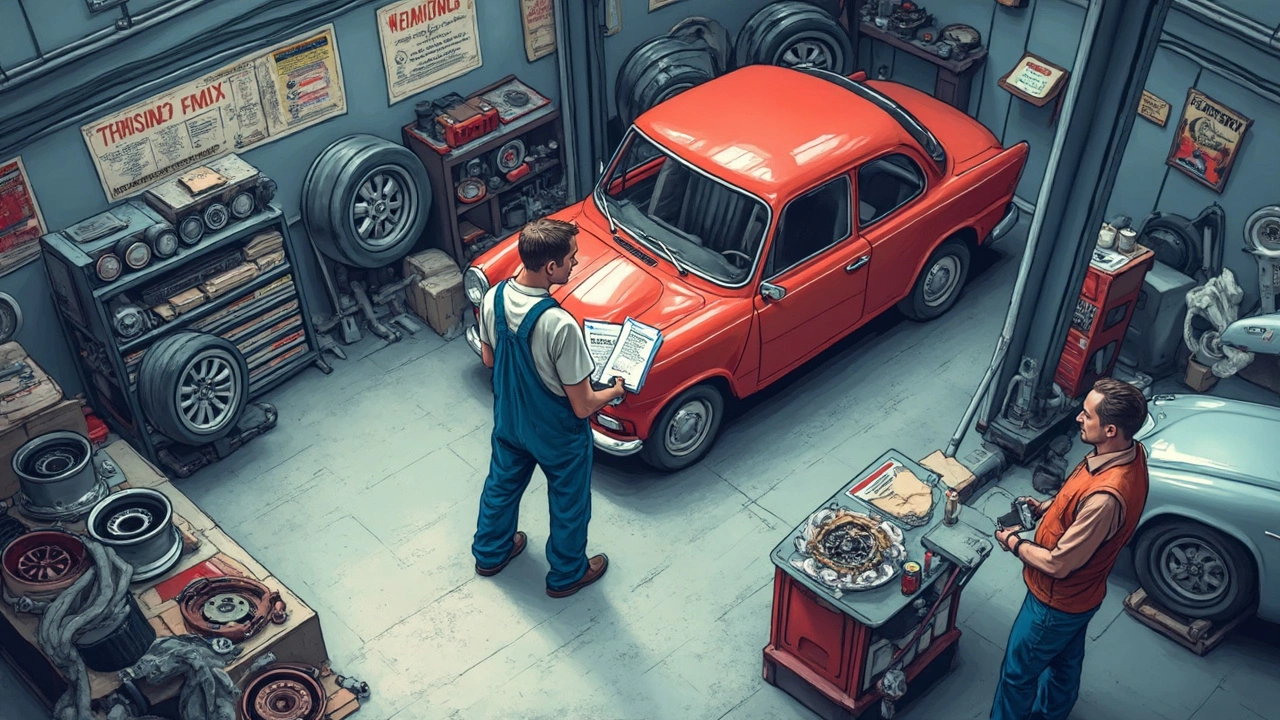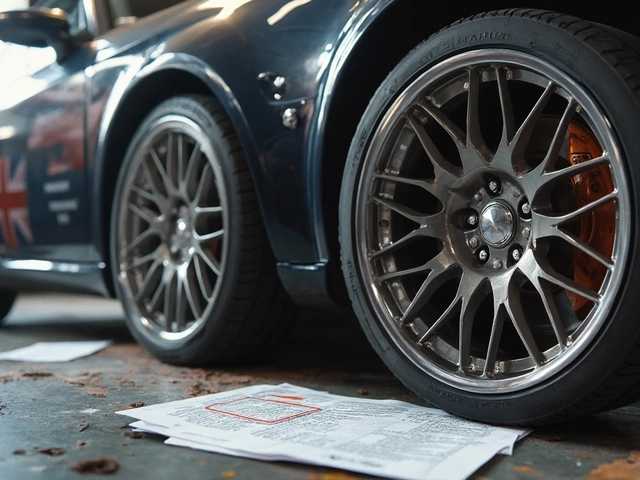Think alloy wheels are just a flashier version of what came with your car? Not quite. These wheels aren’t made from pure steel—they use a mix of metals, usually aluminum blended with a bit of something tougher like magnesium. That’s not just marketing fluff. This blend can make a real difference in how your car feels and drives.
It’s not about just looking good at the traffic lights. Alloy wheels are all about being lighter and easier to handle compared to the old-school steel versions. That lower weight means your suspension doesn’t have to work as hard every time you hit a bump or swerve to avoid a pothole. It also means there’s less strain on your brakes, and—if you like to really press the pedal—you might even feel a bit more zing in your car’s acceleration.
- What Makes Alloy Wheels Different?
- The Real-World Benefits (and Drawbacks)
- How Much Should You Pay?
- Everyday Maintenance and Longevity
- Is the Upgrade Right for You?
What Makes Alloy Wheels Different?
There's a reason car fans and everyday drivers talk about alloy wheels like they’re something special. These aren’t the heavy, plain steel wheels that come on budget cars. Alloys usually mix aluminum with trace amounts of other metals, most often magnesium. This combo gives them a lighter and sometimes even stronger frame compared to plain steel.
The biggest difference shows up in a couple of ways. First, weight savings—sometimes as much as 30% lighter than steel, depending on size and design. That’s not just a number; it means you get easier handling and, in some cases, a small bump in fuel efficiency. Your car has less unsprung weight, so it reacts faster to steering and suspension movements.
Where it gets practical is heat. Alloy wheels do a much better job at spreading out heat from your brakes. Basically, under hard braking, there’s less risk of your brakes fading or losing their bite since alloys cool off faster than steel wheels. If you drive in the city, you notice it after a lot of stop-and-go; on the highway, it’s even more obvious during sudden slowdowns.
- Car wheels made from alloy can be shaped into all sorts of styles. It’s why most sporty or premium cars roll out of the factory with crazy-looking rims you just don’t see on basic models.
- Corrosion resistance is real. Aluminum naturally fights off rust much better than basic steel, meaning your wheels could look sharp for years without turning blotchy or orange.
- Alloys are easier to balance and adjust if you care about ride quality. Less weight at the rim edge means smoother spinning at higher speeds.
Some car brands even claim safety perks, since lighter wheel upgrades can help reduce stopping distance in emergencies. It’s not night and day, but every little bit helps if you’re ever in a pinch.
| Type | Average Weight | Corrosion Resistance | Design Options |
|---|---|---|---|
| Steel Wheels | Heavy | Low | Basic |
| Alloy Wheels | Lighter (up to 30% less) | High | Wide variety |
So, what’s the bottom line? Alloy wheels aren’t just about looking good—they give your car real, practical benefits you’ll notice every day, especially if you pay attention to how your car drives.
The Real-World Benefits (and Drawbacks)
If you’re thinking of shelling out for alloy wheels, you probably want to know what you’re really getting. The shine is nice, but there’s more under the surface. One big win is weight. Alloys are lighter than standard steel wheels, which means your car feels a bit livelier, especially in corners or when you hit the gas. Try tossing a steel rim and an aluminum one side by side—you'll feel the difference right away. Less weight on each corner lets your suspension do its job better, which can help ride comfort and steering response.
Performance isn’t just talk. Lighter wheels can improve acceleration a smidge and might even help your fuel economy, especially on city drives with lots of stop-and-go. Some drivers say they notice the brakes work a bit better, too, since there’s less mass for them to slow down. Keep in mind, don’t expect massive changes. We’re talking single-digit percent improvements—noticeable for some, but not game-changing for most everyday drivers.
Looks do play a part. Alloy wheels come in more designs and finishes, which is why car companies splash them all over new models and why you see them on tuned-up rides everywhere. If you care about your car’s vibe, alloys offer way more options than boring steel covers.
But let’s hit pause on the good stuff. There are drawbacks, too. Even if alloys are stronger in some ways, they’re also more likely to crack if you hit a deep pothole. Steel, meanwhile, tends to bend before it breaks. So, if your roads are more pothole than pavement, you can end up replacing a pricey wheel sooner than you’d like.
Cost hits hard. Aftermarket alloy wheels can run you anywhere from $400 to $2,000 or more for a set, depending on size and brand. Repairs aren’t cheap either—fixing a dent or curb rash often costs more than a quick steel rim repair.
| Benefit | Drawback |
|---|---|
| Lighter weight improves handling | More prone to cracking on rough roads |
| Can boost fuel economy and braking | Higher up-front and repair costs |
| More styles and finishes for looks | Sometimes easier to scratch or dent |
So, are alloy wheels a performance boost or just a style icon? Depends on how you drive, where you live, and how much those little details matter to you.

How Much Should You Pay?
So, what’s the real cost when you’re looking to swap out those factory wheels for alloy wheels? There’s a huge range, and it’s easy to get lost in the hype. Typically, a set of four standard alloy wheels for a typical sedan could run anywhere from $400 up to around $1,200. When you’re eyeing the fancy stuff—think premium brands, bigger sizes, or custom designs—it’s not unusual for the price to hit $2,000 or more. And that’s not even counting installation or new tires.
Here’s a quick snapshot of what you’re really looking at on the bill:
| Type | Average Cost (Set of 4) |
|---|---|
| Budget Aftermarket Alloy Wheels | $400 – $600 |
| Mid-Range Alloy Wheels | $800 – $1,200 |
| Performance or Custom Brands | $1,500 – $2,500+ |
Don’t let discounts fool you. Cheap alloys often mean corners were cut with the materials or the manufacturing. That usually translates into wheels that are more prone to cracking, warping, or chipping. If you’re just gunning for looks and you don’t mind replacing your rims after a couple of winters, go ahead and save a buck. But if you drive a lot, spend more on quality alloy wheels—it’ll pay off later.
Remember, installation matters too. Shops typically charge $100 to $200 for mounting and balancing a set of four wheels, plus the cost of new valves or TPMS sensors if yours won’t transfer over. If you’re buying from a shop instead of online, ask if they’ll throw installation in for free. Some do, most don’t advertise it.
Think about your whole budget—not just the sticker price. Good alloy wheels hold their value, and some insurance companies will even give you a little break on your premium if you upgrade to higher-spec wheels with built-in security options, like locking nuts.
Everyday Maintenance and Longevity
Owning alloy wheels isn’t a “set and forget” deal—they need a bit of regular care if you want them looking sharp and lasting long. The good news? Maintenance isn’t rocket science, but there are a few quirks compared to old-school steel wheels.
First up, alloys are more likely to get scuffed or chipped, especially if you park close to curbs or drive on rough roads a lot. Unlike steel, a banged-up alloy isn’t as easy to just hammer back into shape. A nasty enough hit can mean an expensive repair or even a full replacement. That said, simple scratches can often be covered up with touch-up kits you can grab at most auto shops.
Cleaning should be on your regular routine. Brake dust, dirt, and road salt can really eat away at the finish on alloy wheels. Most folks find a wash every couple of weeks does the trick, using just mild soap and water. Skip the harsh chemicals—stuff like acid-based cleaners will do more harm than good. And don’t skimp on drying them off after a wash, especially in winter, because water left sitting on alloys can cause corrosion over time.
- Check for cracks or bends after big pothole hits. Alloys are tough, but not invincible.
- Use a soft brush or microfiber cloth when cleaning. Steel brushes scratch up the surface fast.
- Wax the wheels a couple of times a year to help keep the finish sealed up.
- If you spot minor corrosion or a chip, sort it out quickly before it spreads.
How long do alloy wheels last? With basic care, most will easily outlive your tires and can go ten years or more. But location matters—a car in a salt-heavy, cold-climate region will see more issues than one cruising sunny routes year-round. Wheel manufacturers usually don’t cover road damage under warranty, so it pays to be careful and protect your investment.
| Maintenance Task | How Often? |
|---|---|
| Full cleaning | Every 2 weeks |
| Wax application | 2-3 times per year |
| Check for damage | After noticeable impacts |
| Basic inspection (for corrosion) | Monthly |
Bottom line: If you don’t mind a little regular TLC, alloy wheels will stay looking good and spinning smooth for years. Ignore them, and you might end up shelling out for repairs that could have been easily avoided.

Is the Upgrade Right for You?
All right, so you’re looking at alloy wheels and wondering if they’re a smart buy. There’s no one-size-fits-all answer—but let’s break it down so you can decide based on your driving style, budget, and what you want from your car.
If you spend most of your time on smooth city streets and mostly care about how your ride looks, alloy wheels definitely bring curb appeal. They come in way more designs and finishes than steel ones, so if style matters, you’ll notice the difference every time you glance back at your car in the parking lot.
For drivers who care about performance, the lighter weight of alloy wheels can make a genuine difference. Less weight means faster acceleration and slightly better gas mileage—sometimes up to 2% improvement. You’ll especially notice the difference if you drive a smaller car or a sporty compact. Car and Driver found that swapping to alloys shaved a few tenths of a second off 0-60 times in cars under 3,500 lbs.
Love road trips or put lots of miles on the odometer? Alloy wheels can help with heat dissipation, so your brakes stay cooler and last longer—helpful if you do a lot of stop-and-go or mountain driving where brakes get a workout.
- If you live somewhere with rough roads, potholes, or harsh winters, keep in mind that alloy wheels are easier to dent or crack than steel. If you’re used to battling curb rash or icy conditions, maybe hang onto steel for winter and swap alloys in for summer.
- If budget is your top priority, remember alloys cost more up front, and repairs for damage can sting your wallet.
- If you regularly tow or haul heavy stuff, double-check the load rating—some alloys aren’t as strong as basic steel wheels for heavy-duty jobs.
One tip: Some people buy a second set of alloy wheels for summer and keep steel for winter with snow tires. This keeps the fancy wheels in better shape and saves money down the line.
Getting alloy wheels is worth it if you value style, lighter handling, or do a lot of spirited driving. But if you’re all about durability, or you’re on a tight budget, steel wheels still do the job. Weigh the pros and cons, and match your choice to how you actually use your car.


